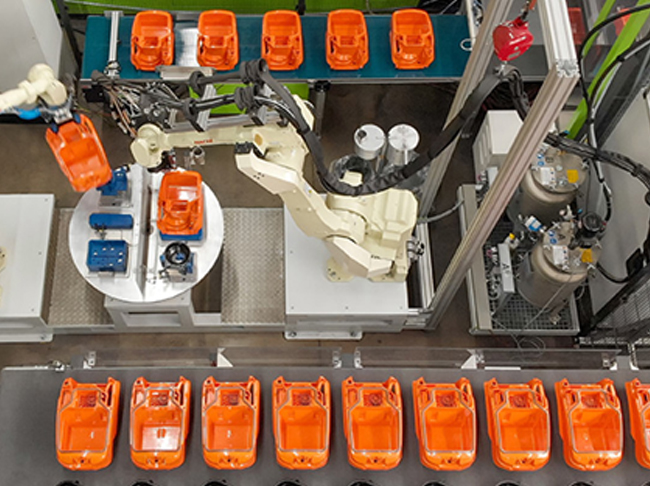For Krug, a high level of automation in production and innovative manufacturing technologies are among the decisive factors for success. These were also implemented in the production line for the manufacture of vacuum cleaner housings with polyurethane foam gasket. For this, Henkel Adhesive Technologies supplied a fully automated system solution comprising foam gasket, dosing machine and process automation. The high availability of the dosing system was the decisive factor for Krug in choosing this solution.
The Sonderhoff DM 502 mixing and dosing machine used for 2 material components meets Krug's high requirements and enables seamless monitoring and compliance with process parameters, e.g. constant temperature setting by means of a greatly improved temperature control system. Efficient production is also ensured by the constant process stability during fully automatic gasket foaming with the Formed-In-Place-Foam-Gasket (FIPFG) technology.
Fully automatic sealing of vacuum cleaner housings
Krug produces ABS vacuum cleaner housings for the Thomas company on an Engel Duo 650. Injection molding production with a 1-cavity mold sets the cycle time for the subsequent process steps, such as sealing, in a 60-second cycle.
The freshly manufactured vacuum cleaner housing is removed from the mold by a removal gripper and conveyed to the waiting and transfer position on a transfer belt. The housing for the motor pot is fed via a second belt and picked up by the 6-axis robot for parts handling.
In addition, the 6-axis robot picks up the vacuum cleaner housing from the transfer position and moves to the rotary indexing table to deposit the parts on the workpiece fixtures. The rotary table rotates 180° to the dispensing position, where the second 6-axis robot with the mixing head successively traverses the contour of the vacuum cleaner housing as well as the motor pot and precisely applies the Sonderhoff Fermapor K31 polyurethane foam. For the removal of the sealed components, the rotary indexing table rotates again by 180°.
For quality control, the 6-axis robot guides the parts under a camera and places the parts checked in this way on the out-cycle conveyor. The gasket cures on this track. The vacuum cleaner housing is then fully assembled and packed for shipping.
Gasket foaming in the injection molding cycle
In inline processing, the pasty (thixotropic) 2-component sealing foam Fermapor K31 is applied to the contour of the vacuum cleaner housing within the cycle time of 60 seconds directly after removal of the injection molded parts according to the FIPFG principle. The material foams by several times its specific volume in the housing groove and cures under room temperature to form a closed flexible foam gasket. The mixed-cell foam structure allows any component tolerances to be compensated. Due to the fast tack-free time, only short transfer belts are required to clock out the parts. The inline process eliminates the need for pre-produced injection molded parts and expensive intermediate storage. This saves space, costs, and time for efficient production.
Managing Director Rüdiger Braun at Krug is very satisfied with the successful commissioning of the Sonderhoff dosing system from Henkel. "Thanks to the possibility of inline production and complete assembly of the dusters directly at the machine, we were able to significantly reduce internal logistics processes." Also decisive for the Sonderhoff system solution were the high expertise of the project management, the short response times, and the willingness to break new ground. In addition, Braun is pleased to say that the high machine availability of the Sonderhoff system is a door opener for new customer orders for sealing components from other industries.

